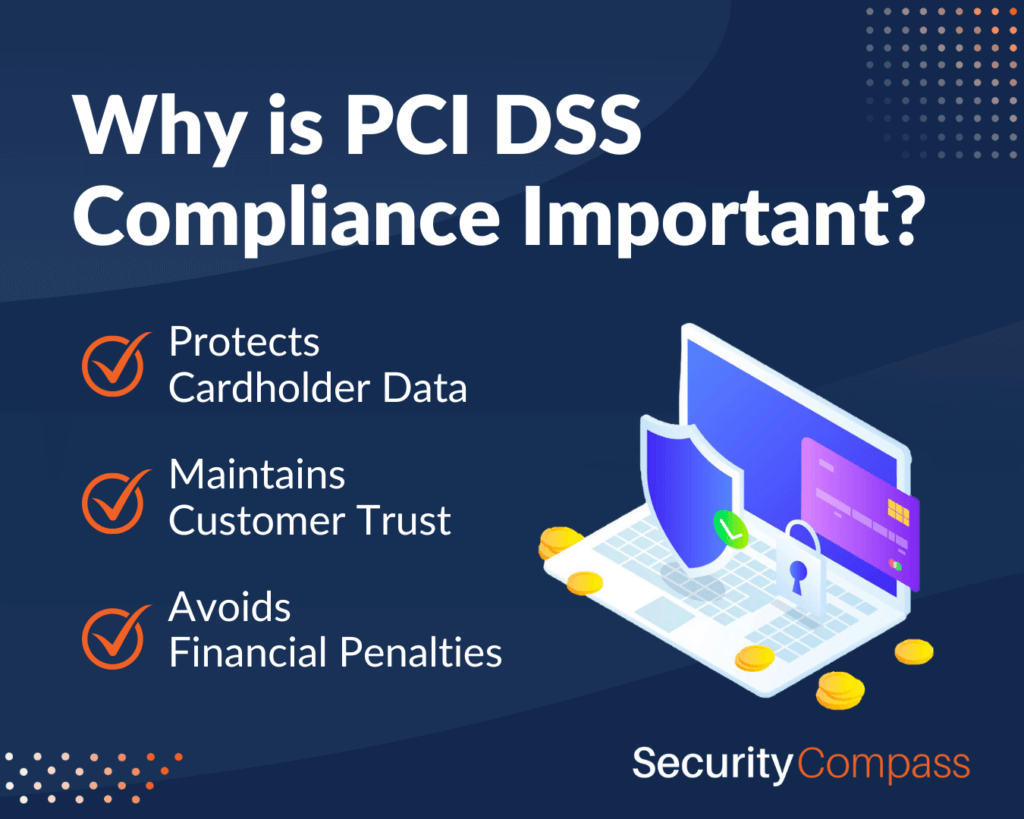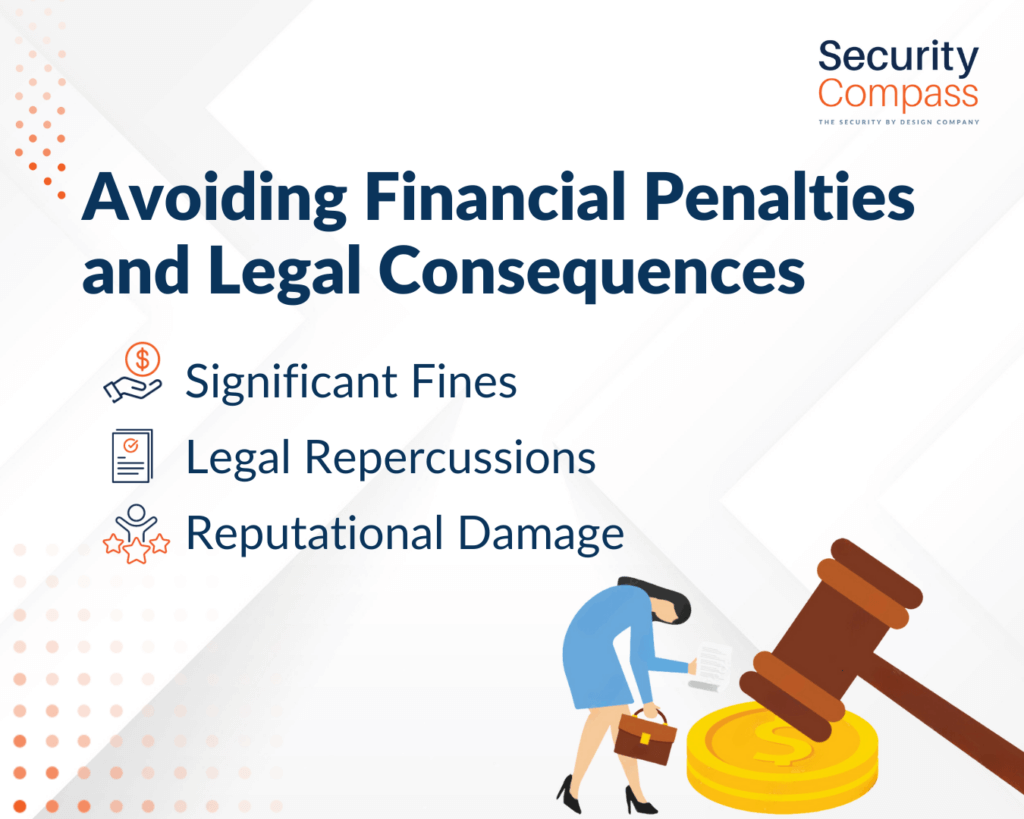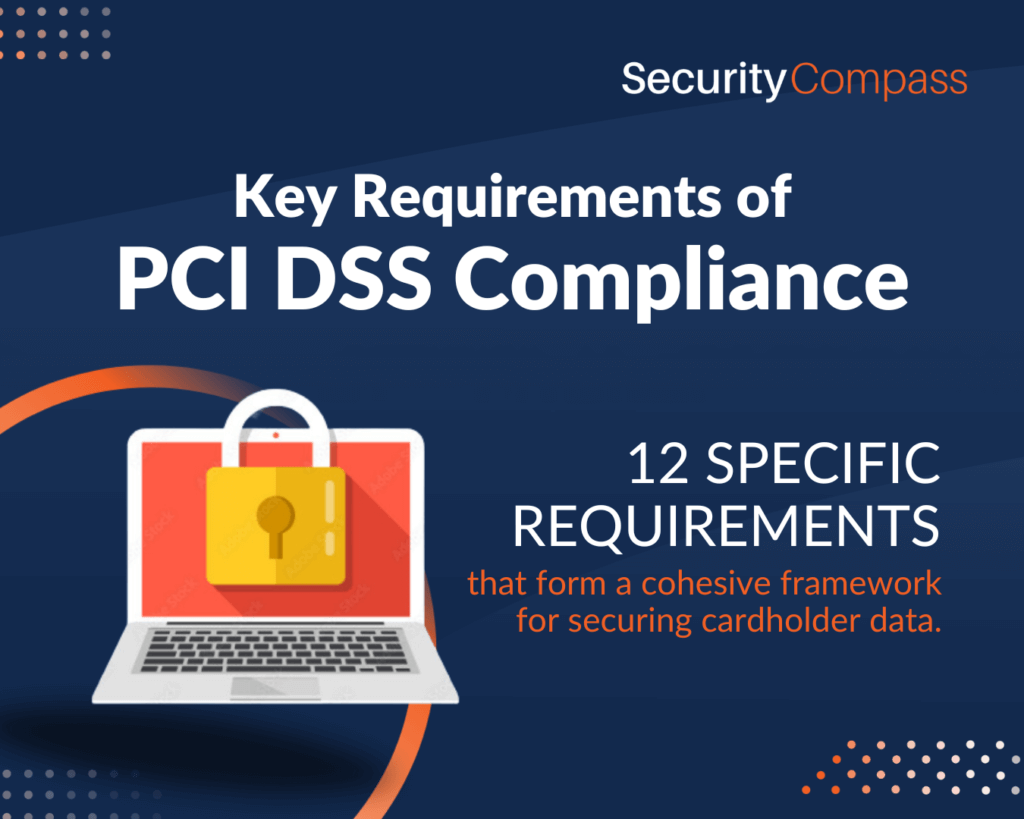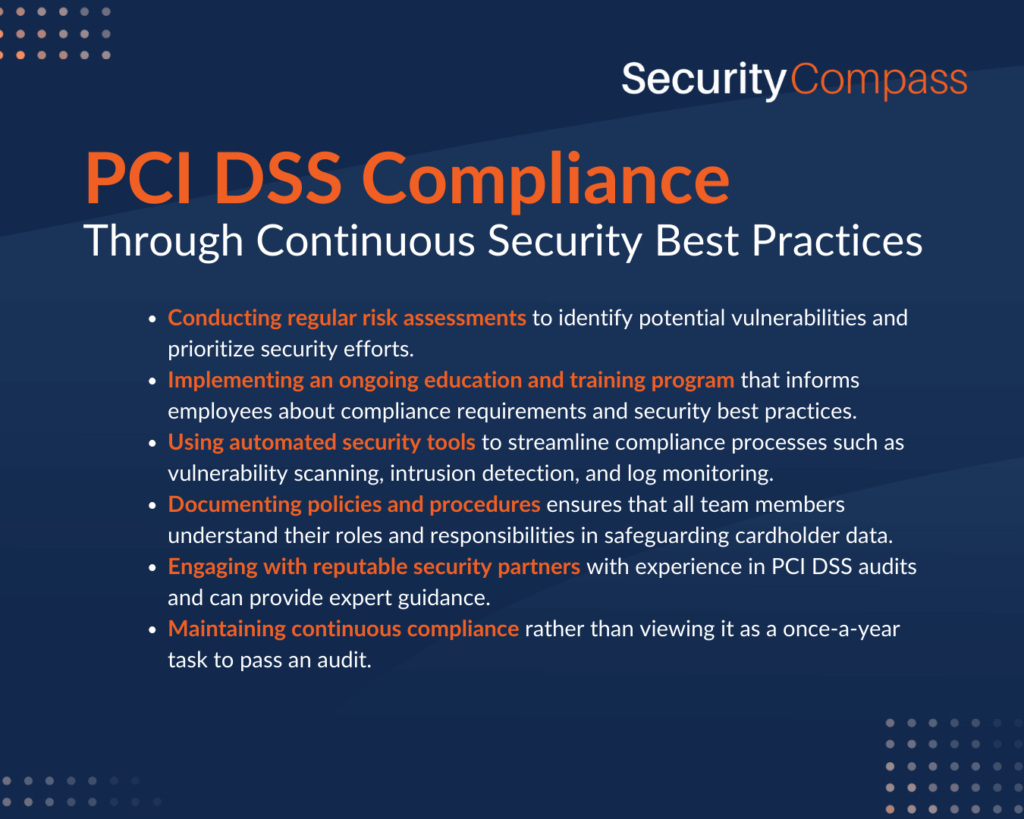PCI DSS compliance protects cardholder data, maintains customer trust, and avoids financial penalties.
In today’s digital era, as most financial transactions occur online, safeguarding cardholder information is paramount. The Payment Card Industry Data Security Standard (PCI DSS) outlines the procedures businesses must follow to secure, store, and transmit data and play a key role in ensuring the security of credit card information.
Businesses entrusted with cardholder data must adhere to these standards regardless of their size because non-compliance can lead to significant consequences, including substantial fines and harm to their reputation.
In this article, we will delve into what PCI DSS is, why it’s vital for your business, and how compliance secures sensitive information and strengthens your customers’ trust. By understanding and implementing the rigorous measures outlined in PCI DSS, companies can navigate the complexities of data security and, in doing so, preserve the integrity of their customer relationships and financial operations.
Let’s examine the importance of PCI DSS compliance as a pivotal component of your business strategy and its foundational role in ensuring data security within the payment card industry.
Understanding PCI DSS
What is PCI DSS?
PCI DSS stands for Payment Card Industry Data Security Standard and is a set of security measures to protect card information.
PCI DSS is designed to solve the growing problem of credit card fraud and data breaches. Established by the Payment Card Industry Security Standards Council, this standard strives to reduce the likelihood of cardholder data compromise by creating a secure data environment.
The History and Evolution of PCI DSS
Since its inception, PCI DSS has evolved to keep pace with new threats and industry trends.
PCI DSS was introduced in 2004 when major credit card companies came together to create a data security standards platform. Since then, the standard has undergone several updates to tackle the evolving nature of cyber threats. These updates reflect changes in technology, market needs, and lessons learned from security incidents, ensuring the standard remains relevant and effective.
Who Needs to be PCI DSS Compliant?
Every entity engaged in payment card processing, encompassing merchants, processors, acquirers, issuers, and service providers, must adhere to PCI DSS compliance requirements.
The level of compliance required varies depending on the volume of transactions a business processes annually. There are four levels of compliance, ranging from Level 1, for the highest transaction volumes to Level 4 for smaller merchants. Each level of PCI DSS compliance comes with distinct validation prerequisites that must be fulfilled. This approach guarantees that businesses put the necessary safeguards in proportion to their exposure and risk.
The Importance of PCI DSS Compliance
Protecting Cardholder Data
PCI DSS compliance is essential for ensuring the confidentiality, integrity, and availability of cardholder data.
The primary goal of compliance with PCI DSS guidelines is to protect credentials from theft, unauthorized access, and fraud. This includes protecting data stored on the card, encryption of card data sent over open public networks, and other important protections. By adhering to PCI DSS compliance, businesses can safeguard sensitive data from potential data breaches, thereby preventing severe harm to the business and its customers.
Maintaining Customer Trust
Adhering to PCI DSS establishes and upholds customer trust by showcasing a firm dedication to data security.
In today’s market, consumer trust is a key competitive differentiator. Customers are inclined to engage with businesses they perceive as taking essential measures to safeguard their personal and financial information. Compliance with PCI DSS is not just a regulatory requirement but a public statement of a company’s dedication to security, which can help retain existing customers and attract new ones.
Avoiding Financial Penalties and Legal Consequences
Non-compliance with PCI DSS can result in significant fines, legal repercussions, and reputational damage.
Non-compliance with PCI DSS regulations exposes businesses to the possibility of financial penalties imposed by payment card companies and acquiring banks. These fines can vary significantly, ranging from a few thousand dollars to several million dollars, contingent upon the violation’s gravity and the offense’s nature.
Moreover, businesses may face legal actions and the costly expenses of fraud recovery, not to mention the long-term reputational damage that can be even more detrimental to business sustainability.
Case Studies: The Cost of Non-Compliance
Historical data breaches have shown the high cost of PCI DSS non-compliance for businesses across industries.
Numerous cases highlight the importance of robust data security practices. For instance, the infamous breach of a major retailer in 2013 led to the theft of payment information for millions of customers and incurred costs exceeding $200 million, including fines, legal fees, and settlement costs. This case and others emphasize the tangible repercussions of overlooking PCI DSS compliance, putting a spotlight on the potential financial and reputational catastrophes.
Key Requirements of PCI DSS Compliance
Understanding the 12 Requirements
PCI DSS comprises 12 specific requirements that form a cohesive framework for securing cardholder data.
To meet PCI DSS compliance, businesses are required to adhere to the following 12 requirements. These requirements are designed to establish a secure network and systems, protect cardholder data, maintain a vulnerability management program, implement robust access control measures, regularly monitor and test networks, and enforce an information security policy.
- Install and manage firewall settings to protect credentials.
- Do not use system passwords or other security measures not provided by the vendor.
- Protect the information stored on the cardholder.
- Do not use system passwords or other security measures not provided by the vendor.
- Protect all systems from malware and regularly update antivirus software or programs.
- Design and manage security and implementation.
- Restrict access to cardholder data on a need-to-know basis.
- Identify and authenticate access to system components.
- Restrict physical access to cardholder data.
- Track and monitor all access to network resources and cardholder data.
- Regularly test security systems and processes.
- Implement policies that address safety issues for all employees.
Each requirement encompasses a series of detailed sub-requirements that further delineate the necessary controls and procedures to safeguard cardholder data effectively.
Implementing Strong Access Control Measures
Controlling who has access to cardholder data is a fundamental aspect of PCI DSS compliance.
Access control measures ensure that only authorized personnel can access sensitive data. This reduces the risk of accidental data exposure and minimizes the potential for malicious insider activities. To achieve this level of control, businesses can employ principles such as least privilege access, implement multi-factor authentication, and manage unique IDs for each user.
Maintaining a Vulnerability Management Program
An effective vulnerability management program is at the heart of PCI DSS compliance efforts.
Regularly identifying, assessing, and mitigating vulnerabilities within the card data environment is a continuous process that requires diligence and up-to-date intelligence on the latest cybersecurity threats. This involves deploying secure coding practices, conducting regular vulnerability scans and penetration tests, patching systems in a timely manner, and having preventative controls in place to tackle potential weak points.
Regular Monitoring and Testing of Networks
Maintaining PCI DSS compliance status requires continuous monitoring and regular network security testing. These practices are essential to ensure ongoing compliance and cardholder data security.
Ongoing surveillance and regular testing of security systems and processes ensure vulnerabilities are swiftly detected and addressed. This includes performing intrusion detection and prevention, implementing file integrity monitoring, and confirming that the outlined security measures and controls are always effective and operational. Keeping a vigilant eye on network activity through continuous monitoring is key to promptly responding to irregularities and possible security breaches.
Compliance Challenges and Best Practices
Common Challenges in Achieving Compliance
Organizations often face obstacles such as limited resources, changing regulations, and complex environments in their journey to PCI DSS compliance.
The journey to achieve and sustain PCI DSS compliance can be demanding, particularly for small to medium-sized businesses with constrained budgets and IT resources. The ever-changing terrain of technology and cyber threats adds layer of complexity, compelling organizations to regularly adapt their security measures to remain compliant and effectively safeguard cardholder data.
Additionally, companies with complex infrastructures or those that outsource payment processing may find managing and overseeing compliance across multiple vendors and systems challenging.
Best Practices for Ensuring Compliance
Consistent adherence to security best practices is critical for seamlessly maintaining PCI DSS compliance.
To effectively navigate compliance challenges, businesses can adopt a set of best practices:
- Conducting regular risk assessments to identify potential vulnerabilities and prioritize security efforts.
- Implementing an ongoing education and training program that informs employees about compliance requirements and security best practices.
- Using automated security tools to streamline compliance processes such as vulnerability scanning, intrusion detection, and log monitoring.
- Documenting policies and procedures ensures that all team members understand their roles and responsibilities in safeguarding cardholder data.
- Engaging with reputable security partners with experience in PCI DSS audits and can provide expert guidance.
- Maintaining continuous compliance rather than viewing it as a once-a-year task to pass an audit.
Following these practices helps organizations create an effective security posture that dynamically responds to new threats while ensuring ongoing compliance with PCI DSS standards.
The Role of Security Companies in PCI DSS Compliance
Expert security companies can be crucial in guiding organizations toward sustainable PCI DSS compliance.
While some organizations may have the resources and expertise to manage PCI DSS compliance internally, many can benefit from partnering with specialized security companies. These partners can offer various services, including risk assessments, compliance audits, security training, and implementation support for security technologies.
By leveraging the expertise of security companies, businesses can navigate the complexities of PCI DSS more effectively, ensuring that compliance is achieved and seamlessly integrated into their operational workflows.
Security Compass, for example, is a leader in security by design and helps organizations build security directly into their DevSecOps processes to maintain compliance without sacrificing development speed or innovation.
The Future of PCI DSS Compliance
Emerging Technologies and PCI DSS
The integration of emerging technologies presents new opportunities and challenges for PCI DSS compliance.
As new payment methods and technologies such as mobile wallets, blockchain, and Internet of Things (IoT) devices become more prevalent, they also introduce new vectors for potential security vulnerabilities. PCI DSS standards must adapt to these new technologies to protect cardholder data across all platforms. Organizations must stay informed about these technological advances and how they affect security requirements, ensuring compliance within these evolving infrastructures.
Predictions for PCI DSS Evolution
Continuous updates to PCI DSS are expected as payment technologies and cyber threats develop.
The Payment Card Industry Security Standards Council actively monitors the evolving landscape of cyber threats and payment technologies to update and refine PCI DSS. Future versions of the standard are likely to address the security concerns presented by emerging technologies and refine current requirements to close any gaps exploited by cybercriminals. Anticipating and preparing for these changes will be key for businesses wanting to stay ahead regarding compliance and data security.
Businesses should adopt a proactive and forward-thinking stance towards security and compliance to anticipate and effectively address these advancements. This approach helps guarantee the safety and privacy of customer data in an ever-evolving digital landscape, regardless of how payment processes evolve.
Conclusion
PCI DSS compliance is far more than a set of obligatory guidelines to follow; it is a critical foundation for securing cardholder data that benefits both businesses and consumers. By adhering to the 12 PCI DSS requirements, organizations protect themselves from data breaches and the associated financial and reputational damages and foster customer trust and loyalty through demonstrable security practices.
Achieving PCI DSS compliance can pose challenges, but with the correct approach, resources, and expertise, it is attainable for businesses of all sizes. As technology advances and cyber threats evolve, PCI DSS standards will adapt to ensure their relevance and effectiveness in addressing emerging challenges.
Ultimately, the significance of PCI DSS compliance cannot be emphasized enough. Safeguarding cardholder data is fundamental for the integrity and prosperity of any business engaged in payment card processing. Regular evaluation, a commitment to best practices, and a robust partnership with security experts can help businesses maintain a secure environment that aligns with these essential standards.
Frequently Asked Questions
What is PCI DSS Compliance, and Who Does it Apply To?
PCI DSS compliance requires adherence to a precisely defined set of security standards crafted to protect cardholder data. It is mandatory for all entities participating in card transactions.
Every organization involved in processing, storing, or transmitting credit card information, including merchants, payment gateways, service providers, and banks, must adhere to PCI DSS to guarantee the security of cardholder data during transactions and while it is stored within their systems.
Why is PCI DSS Compliance Mandatory?
PCI DSS compliance is mandatory because it helps prevent credit card fraud, data breaches, and identity theft.
This standard offers a framework for organizations to establish a secure environment for card transactions. Compliance is enforced by the major credit card companies and non-compliance can result in fines, increased transaction fees, or even a revocation of card processing privileges.
How Often Should an Organization Validate PCI DSS Compliance?
Organizations should validate PCI DSS compliance at least annually, but continual assessment and monitoring are recommended.
Validation frequency can also depend on the compliance level required by the volume of transactions processed by the business, with some entities, such as those at Level 1, needing to undergo external audits by qualified assessors.
How Much Can PCI DSS Non-Compliance Cost a Business?
Non-compliance with PCI DSS can result in various consequences, including monetary penalties, operational disruptions, and significant damage to the organization’s reputation.
Penalties for non-compliance can be substantial—a business may face fines from payment brands, incur costs for forensic audits and remediation, suffer loss of sales, and experience erosion of customer trust which can have longer-term financial implications.
What are the Main Challenges Businesses Face with PCI DSS Compliance?
Challenges can include understanding the complexities of the standard, keeping up with evolving technology and threats, and allocating sufficient resources to security measures.
Additionally, companies may need help adequately training staff, managing third-party risks, and maintaining continuous compliance in their daily operations.
Can Small Businesses Achieve PCI DSS Compliance Cost-Effectively?
Small businesses can cost-effectively achieve PCI DSS compliance by focusing on controls relevant to their specific environment and seeking professional guidance when necessary.
Utilizing basic security measures, narrowing the scope of compliance, leveraging self-assessment questionnaires, and adopting simplified payment solutions can reduce the burden and costs associated with achieving compliance.
How Can Security Companies Assist with PCI DSS Compliance?
Security companies can provide valuable assistance with tasks such as conducting gap analysis, devising remediation plans, validating compliance, and offering ongoing support to uphold PCI DSS standards.
Experienced security specialists can provide tailored solutions and guidance, which help businesses navigate the complex route to compliance with less strain on internal resources.
By providing clear and informative responses to these commonly asked questions, businesses can enhance their understanding of the importance of PCI DSS compliance and make well-informed decisions to secure their operations and protect their customers’ data.
Do you have questions about PCI DSS? Feel free to contact us.













